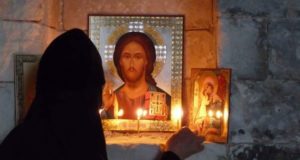قتل أطفال مكتملي التكوين عن طريق حقنهم بالديجوكسين أو كلوريد البوتاسيوم..
الطريقة الأكثر شيوعًا لإجهاض الأطفال في الثلث الثاني من الحمل هي (إجراء شنيع) متمثل في “التوسيع والاستخراج”، ويستخدم المجهض مشبك – أداة إمساك فيها صفوف من “الأسنان” الحادة – لإمساك ذراعي وساقي الطفل وسحبهما، وتمزيق الأطراف من جسم الطفل. يستمر المجهض في الإمساك بالأمعاء والعمود الفقري والقلب والرئتين وأي أطراف أو أجزاء أخرى من الجسم. عادةً ما يكون الجزء الأصعب من الإجراء هو العثور على رأس الطفل وإمساكه وسحقه..
عرفت الهند حوالي 15.6 مليون حالة إجهاض في الهند عام 2015، متوقّع أن يتضاعف الرقم..
بقلم ريموند وولف – الإجهاض بين 20 و 24 أسبوعًا لأسباب “علاجية ، تحسين النسل ، إنسانية واجتماعية” أصبح الآن قانونيًا ، مع امتدادات للأطفال الذين يعانون من “تشوهات جنينية كبيرة”.
أقر البرلمان الهندي قانونًا يجيز الإجهاض (الأسبوع الماضي)، حتى لحظة الولادة ، دون إدانة تذكر من الكنيسة الكاثوليكية.
تصويت المجلس التشريعي، يوم الثلاثاء الماضي (16 آذار 2021) أضفى الشرعية على نطاق واسع على قتل الأطفال الذين لم يولدوا بعد حتى 24 أسبوعًا من الحمل (6 أشهر).
يسمح القانون الهندي الحالي بالفعل بالإجهاض بين 12 و 20 أسبوعًا من الحمل إذا قام طبيبان على الأقل بتوقيعه.
التشريع الجديد ، المسمى تعديل الإنهاء الطبي للحمل ، يحرر لوائح الإجهاض بشكل أكبر، مما يسمح بالإجهاض حتى 20 أسبوعًا من الحمل بناءً على رأي طبيب واحد. كما يشرّع مشروع القانون الإجهاض بين 20 و 24 أسبوعًا لأسباب “علاجية وتحسين النسل وإنسانية واجتماعية”.
بحلول الأسبوع العشرين ، يبلغ طول الأطفال الذين لم يولدوا بعد قدمًا واحدة تقريبًا ويشعرون بالألم ، وأحيانًا تكون الحساسية أكبر من البالغين. في الأسبوع الرابع والعشرين ، يكون لدى الأطفال أعضاء وعضلات وجه متطورة للغاية ، ويكونون قادرين على البقاء مع العلاج المناسب. على سبيل المثال ، أفادت الخدمة الإخبارية لأبرشية فيرابولي الكاثوليكية بالهند في أواخر العام الماضي أن طفلاً في ولاية كيرالا الهندية نجا بعد ولادته بعمر 23 أسبوعًا وأقل من رطل واحد.
الطريقة الأكثر شيوعًا لإجهاض الأطفال في الثلث الثاني من الحمل هي (إجراء شنيع) متمثل في “التوسيع والاستخراج”، ويستخدم المجهض مشبك – أداة إمساك فيها صفوف من “الأسنان” الحادة – لإمساك ذراعي وساقي الطفل وسحبهما، وتمزيق الأطراف من جسم الطفل. يستمر المجهض في الإمساك بالأمعاء والعمود الفقري والقلب والرئتين وأي أطراف أو أجزاء أخرى من الجسم. عادةً ما يكون الجزء الأصعب من الإجراء هو العثور على رأس الطفل وإمساكه وسحقه.
ويمكن أيضًا استخدام تقنيات التقطيع في عمليات الإجهاض المتأخرة، والتي عادةً ما تتضمن قتل أطفال مكتمل التكوين أحيانًا عن طريق حقنهم بالديجوكسين أو كلوريد البوتاسيوم. الأم التي خضعت لهذا الإجراء لا يزال عليها أن تمر بالمخاض والولادة ، وتلد جسد طفلها الميت.
من المتوقع أن يؤدي التوسع في الإجهاض المتأخر في الهند إلى رفع معدل الإجهاض المرتفع بشكل استثنائي في البلاد. قال رئيس الأساقفة الدكتور جوزيف كالاثيبارامبيل (Archbishop Dr. Joseph Kalathiparambil) في وقت سابق من هذا العام: “حدثت حوالي 15.6 مليون حالة إجهاض في الهند في عام 2015. إذا تم تنفيذ القانون الجديد ، فسيتم مضاعفة هذا العدد”.
“يجب على كل من يفهم قيمة الحياة أن يحتج على مشروع القانون. لا يجب أن نبقى صامتين عندما يُقتل الأطفال الأبرياء. إذا اخترنا عدم الرد ، فسنكون جميعًا مسؤولين عن موتهم “..
المصدر: lifesitenews.com
India passes radical late-term abortion bill, with Church being largely silent
By Raymond Wolfe – Abortion between 20 and 24 weeks for ‘therapeutic, eugenic, humanitarian and social’ reasons will now be legal, with extensions for babies with ‘substantial fetal abnormalities.’
The Parliament of India passed a radical pro-abortion bill last week, authorizing late-term abortion up to the moment of birth, with little condemnation from the Catholic Church.
Rayja Shaba, India’s upper legislative chamber, voted last Tuesday to broadly legalize the killing of unborn babies up to 24 weeks into pregnancy, NDTV reported. The lower chamber of India had approved the bill last March.
Current Indian law already permits abortions between 12 and 20 weeks of pregnancy if at least two doctors sign off on it.
The new legislation, called the Medical Termination of Pregnancy Amendment, liberalizes abortion regulations even further, allowing abortion until 20 weeks of pregnancy based on a single doctor’s opinion. The bill also legalizes abortion between 20 and 24 weeks for “therapeutic, eugenic, humanitarian and social” reasons.
The 24-week limit could be extended, however, for babies with “substantial fetal abnormalities,” greenlighting abortion virtually up to the moment of birth.
By 20 weeks, unborn babies are nearly one foot long and feel pain, sometimes with greater sensitivity than adults. At 24 weeks, babies have highly developed organs and facial muscles, and are viable with proper treatment. For example, the news service of the Catholic archdiocese of Verapoly, India, reported late last year that a baby in the Indian state of Kerala survived after being born at 23 weeks and under 1 pound.
The most common method of aborting babies in the second trimester is the gruesome procedure of “dilation and extraction,” also known as dismemberment abortion. In the case of dismemberment abortion, as Live Action notes,
the abortionist uses a sopher clamp — a grasping instrument with rows of sharp “teeth” — to grasp and pull the baby’s arms and legs, tearing the limbs from the child’s body. The abortionist continues to grasp intestines, spine, heart, lungs, and any other limbs or body parts. The most difficult part of the procedure is usually finding, grasping and crushing the baby’s head.
Dismemberment techniques can be used in late-term abortions as well, which typically involve killing sometimes fully formed babies by injecting them with digoxin or potassium chloride. A mother who undergoes that procedure still has to go through labor and delivery, birthing her dead baby’s body.
The expansion of late-term abortion in India is expected to dramatically raise the country’s exceptionally high abortion rate. “Around 15.6 million abortions took place in India in 2015. If the new Act gets implemented, this number will be doubled,” Verapoly Archbishop Dr. Joseph Kalathiparambil said earlier this year.
“Everyone who understands the value of a life should protest against the Bill. We shouldn’t remain silent when innocent babies are being killed. If we choose not to react, all of us will be responsible for their death,” he continued.
The Catholic Church in India nevertheless has remained largely silent on the passage of the bill, with little condemnation from the official channels of the Indian bishops’ conference. Although the bishops of Kerala had slammed the bill last month, and committed to organizing statewide protests against it, few demonstrations appear to have materialized.
“There is radio silence from the Church,” one commentator, Dr. Sharon Fredrick Lasrado, said on Tuesday. “[I]t has failed to even register a token protest against the passage of the bill,” she added.
 Agoraleaks Agoraleaks
Agoraleaks Agoraleaks







